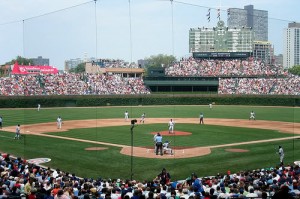Nearing its 100th birthday, Wrigley Field is the home ballpark for the Chicago Cubs. Wrigley is the second oldest active major league ballpark after Boston’s Fenway Park. It also enjoys the distinction of being the only active stadium that once hosted games in the short-lived Federal League during the 1910s.
Constructed in 1913, Wrigley Field was originally planned and built for the Fed League’s Chicago Whales, but it has been the home of the Chicago Cubs for virtually its entire life.
The park was constructed in only six months. The man who built it was the lunchroom magnate “Lucky Charlie” Wheegman, owner of the Whales. The architect was Zachary Taylor. Taylor who also built Comiskey Park, home of the Chicago White Sox. When it was built, Wrigley was seen as state of the art construction, incorporating the new building fire codes of that time. It was built at a cost of $250,000. Adjusting for inflation, this would amount to $5.3 million today.
When it opened, the seating capacity was 20,000 people. The Federal League closed its doors in 1915 and both the Cubs and the ballpark were sold to Wrigley. For a short period, from 1920 to 1926, it was also known as Cubs Park as well, before being christened as Wrigley Field after team owner William Wrigley Jr.
The Cubs played in a couple of World Series at Wrigley Field—the last a 1945 loss to the Detroit Tigers. Otherwise, the team hasn’t seen a World Series during the park’s entire existence, a fact long-suffering Cubs fans know all too well. They haven’t won one since 1908, before Wrigley was built. Still, north side Chicago baseball fans have seen some great games and players pass through.
 The outfield bleachers were built in 1937 and the Cubs’ famous manually operated scoreboard was constructed that same same year. The Wrigley Field bleachers, sometimes rowdy and a haven for beer-drinking fans, are among the most famous and coveted seats in baseball.
The outfield bleachers were built in 1937 and the Cubs’ famous manually operated scoreboard was constructed that same same year. The Wrigley Field bleachers, sometimes rowdy and a haven for beer-drinking fans, are among the most famous and coveted seats in baseball.
Famous games and moments ooze from the bricks and the ivy-covered outfield walls. Babe Ruth’s “Called Shot” in the 1932 World Series. Incredible performances by Hall of Famer Ryne Sandberg in the 1980s. The grace and charm of Ernie Banks, who hit his 500th homer there. Cubs announcer Harry Caray sang “Take Me Out to the Ballgame” out the press box window during the 7th inning stretch of every home game, adding to the park’s charm.
Wrigley also served as the home stadium for the NFL’s Chicago Bears from 1921 to 1970.
Wrigley Field now has a total seating capacity of 41,118. This makes it the fourth smallest active major league baseball stadium. Although a popular venue, Wrigley Field did not install lights until 1988, but The Cubs were not allowed to play any games post baseball season without lights and so the lights were installed. Even today, the number of night games is kept to a minimum at Wrigley Field.
Sorry there were no results or an error